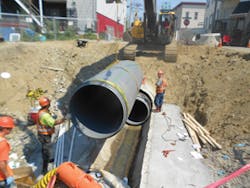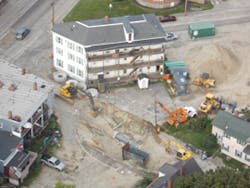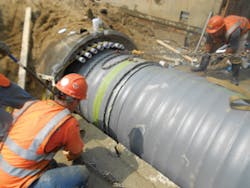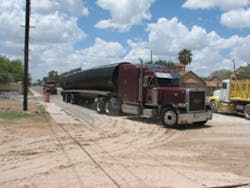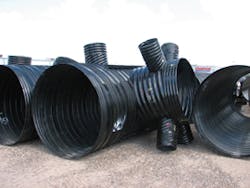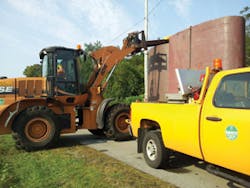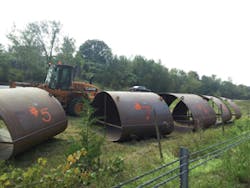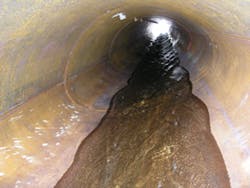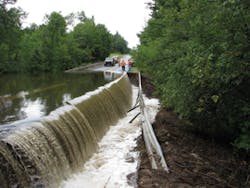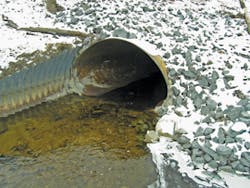A pipe’s age, along with normal wear and tear, can cause systems to break down. During the winter of 2013–14, record cold temperatures across much of the nation also caused pipe failures, often in water mains. At such times especially, it’s important to fix the problem quickly–not only to resume service, but also to keep crews in dangerous weather for the shortest time possible. Many cities these days are finding a variety of solutions to help get the job done.
Taking Care in Tight Spaces
Even in good years, winters in Maine can be long and difficult, so projects must be completed quickly between April and November. During that period in 2012, the city of Lewiston continued its combined sewer overflow (CSO) separation initiative along Oak Street. The challenges piled up: Crews had to work around a massive rock ledge, old buildings sat virtually on the edge of the trench, and an existing sewer was found to be leaking.
“Although we usually hit clay, sometimes when digging we hit rock. Of course, in the earlier months, it was difficult to tell which was which, as the frost line here goes down to about four feet,” says Jeffrey D. Beaule, P.E., project engineer for Lewiston Public Works. “The existing pipes were already fairly deep. Water mains are five-and-a-half feet down–nothing’s situated less than that. We had to use a big jackhammer on the excavator, because the houses were right there behind the sidewalk–there was not enough room to blast safely. The rock was very hard and didn’t want to break up very easily. We made some test holes every 25 feet to know how deep the rock was.”
The city’s in-house engineering department used flexibility in permitting and designing the project. Local engineers were used for construction inspection, as well as trusted local contractors who were very familiar with the city’s infrastructure. Locally manufactured products were also sought to address all challenges–within the project’s budget and timeline. “I designed the plan myself at the city engineering office,” says Beaule. “Gendron & Gendron did the work, and E. J. Prescott was the pipe supplier.”
The pipe supplied was Hilliard, OH’s Advanced Drainage Systems SaniTite HP pipe.
“The city of Portland had used ADS pipe the year before. Another engineer had consulted with the City and knew of the product, so SaniTite sounded like a good idea. Concrete pipe would’ve been more expensive, as well as taking more time to install,” says Beaule. Another advantage of the ADS pipe: it can be used in any soil type; it stands up to 1.5 to 14 pH.
Of course, once excavation began, there were more problems than just sewer separation. “Electric wires aren’t underground, but the phone lines are, which were laid in concrete, but some in very old tile, which broke apart easily when you got near them,” continues Beaule. “But that’s not to say the electric lines didn’t cause difficulties. Gendron had to buy a special excavator, a Volvo 305 with no rear counterweight, so the machine could get past the buildings. They dug down three feet into the street, so the excavator could sit in the hole and reach everything. Even at that level, if the operator opened the excavator’s roof, he’d hit the overhead wires. Then, of course, we found a large sewer that had to be relined with SaniTite, because it was leaking.”The Oak Street project had some deep cuts–down 25 to 30 feet in certain areas. Maneuvering the pipe was difficult, especially since one city block was only 40 to 50 feet across. In such a congested area, dug-out material had to be loaded into dump trucks and sent off for storage; there was nowhere to store it onsite. Once the installation was completed and compacted, material was hauled back in to reconstruct the roadway. With such a complicated install, it took a six-member crew eight months to install 800 feet of pipe. Typically, a “normal” project of this size would take just a few days.
However, the ADS pipes made the job easier in many respects. Joints, bends, and “Ts” could be made to spec, which was a boon, since the pipe trails were very complex. The system included 90-degree and 45-degree connections, and some 22-degree bends; ADS even made a pipe that came up at a 45-degree angle, and back at another 45-degree angle.
“The CSO project was very challenging and time consuming. When the crew got near a more-than-50-year-old, 60-inch concrete transmission sewer main, they found the joints were leaking–there were no gaskets in the pipe–so they had to install another 400 feet of 48-inch SaniTite HP pipe to segmentally slipline and rehabilitate the sewer pipe,” explains Beaule. “With the effluent pouring into the trench, it was decided that we needed to do something quickly, and sliplining seemed to be the best option since we already had a big hole opened. We didn’t have to bypass the flows; the crew just pushed the new pipe through. We would have had to set up more bypass pumps if we’d had to replace the pipe.”
Work continues on Oak St. “Other separation work is being done around the city. Three other contracts are wrapping up this year. We have been working on stormwater and sewer separation for the last 15 years–this is the final year of a $30 million plan,” concludes Beaule.
The CMP pipes were much lighter in weight than equivalent concrete pipes, and came in much longer lengths—20 feet versus concrete’s 8 feet.
Good Pipe Goes Pharr
“Replacing” is usually much more difficult than “installing,” and few things illustrate that better than upgrading underground pipes. During installation, except for some vegetation, the area was likely empty land; however, development quickly makes that same land crowded with homes, shops, and other buildings–all of which belong to someone other than the city. In addition to saving money during repairs, city crews must be careful not to disrupt property owners’ land or utilities–at least, not for long lengths of time.
In fall 2012, during the ongoing effort to replace aging and inadequate storm drainage systems, the city of Pharr, TX, and the Texas General Land Office upgraded a smaller reinforced concrete pipe (RCP) drainage system. The task included a main trunk line of large box culverts that collected surface runoff from nearly 320 acres of densely populated residential and commercial areas. With such tight site constraints, the needed concrete boxes would be difficult to install; in addition, the manufacturing costs and logistics required were expensive and exceeded the project’s budget.
“This area was mostly residential, with some commercial sites,” says Pharr City engineer William Ueckert Jr., P.E. “Some of the existing stormwater pipes were 30 to 40 years old, and some were undersized for the population growth we’d had during the years. We had a budget; the original bids were for reinforced concrete pipe. Contech said we could save money–maybe $200,000–with its pipe.”
Contech Engineered Solutions of West Chester, OH, manufactures a variety of pipes for many applications: corrugated metal pipe (CMP), PVC, HDPE, and steel-reinforced polyethylene (SRPE). Pharr selected Contech’s polymer-coated Ultra Flo, a hydraulically efficient CMP with a smooth interior surface. A local subcontractor made the Contech pipes; shipping pipe all the way from Ohio would not have been cost effective.
CMP’s lesser weight was also a bonus. “We didn’t require a crane on this project, due to weight of Contech’s material. The pipe was loaded and installed with a front-end loader,” explains Ueckert. “As much of this was in a residential area, a crane would be extremely heavy and might have damaged the streets. Plus, we would have had to close the streets completely if using a crane. The pipes assembled faster, as well, as these came in 20-foot segments, whereas concrete pipe is only eight feet. So Contech was not only less weight, but also more efficient, time-wise.” The installation took approximately six months, well under the original time estimated.
Contech’s fittings are used extensively to eliminate manholes, elbows, and junction boxes.
In the original plans, a 36-inch pipe had been specified to go through a 48-inch casing pipe bored under the highway. However, because of Ultra Flo’s thinner wall, the pipe used was 42 inches, increasing flow capacity. “Under highways, and within their rights of way, TxDOT requires casing on any size of pipe. That isn’t really relining, but a protection for the inner pipe,” says Ueckert. “If repairs have to be made, all the State Highway Department has to do is pull the pipe from the casing.”
Contech modeled the system internally to ensure hydraulic equivalency of 78-inch round pipe to 8-foot-by-4-foot and 7-foot-by-5-foot boxes. The 12-gauge polymer coating provided added durability and the required service life. “The Ultra Flo is sort of like a galvanized pipe, but it’s steel, coated inside and out with a black polymer coating, which keeps acid soils from eroding the pipe,” notes Ueckert.
All told, there was $90,000 in savings to the city. “With the tight constraints of the project in a residential area, the alternative solution of using Ultra Flo was the answer,” says Ueckert.
“This project was the first time we’d used Contech. Saenz Utility Contractors, not city workers, performed the work; this was its first Contech project too, and it had no problems. Since then, we’ve used this product on two other projects, and a private firm now constructing a mall area is using that pipe as well. We’re very happy with it. For drainage projects, I’d definitely recommend that pipe.”
Many Hands Make Pipe Work
As frustrating as detours can be in a city, in a rural area they can add up to miles of driving around. When two culverts in St. Lawrence County, NY–one under State Route 12, another under County Route 47–needed to be repaired, lessening the impact for residents was a major concern. “Replacing the culvert would have meant rerouting traffic for some time, and sometimes to go around is a long way around–24 miles in this case,” says St. Lawrence County senior civil engineer Andrew Willard, P.E.
Willard and Ernest Olin, P.E., NYSDOT resident engineer for St. Lawrence County, often “talk shop,” and did so especially at this time, when they both faced a similar problem. “Andy [Willard] had seen the InfraSteel product at a trade show and brought up the possibility of a shared services arrangement, where our departments could aid each other to install this product on the state system and the county system,” says Olin.
A product of Birmingham, Alabama’s Precision Pipe & Products Inc., InfraSteel, a permanent culvert rehabilitation system, has been designed to offer cost-effective and environmentally friendly alternatives to culvert preservation and rehabilitation.
Just a few years earlier, severe flooding had caused a collapse of the roadway above CR 47’s culvert. “This culvert was coming up for replacement project soon anyway. It dated from the 1960s, the bottom was rusted through, and it was losing soil underneath,” explains Willlard. “At first, the only realistic option was total replacement, as the culvert was too large for a typical round slipliner; there would have been too much loss of hydraulics with round, as the existing structure was a corrugated metal pipe arch [CMPA]. We’ve been very proactive in the last several years looking at new technology, such as GRS-IBS [Geosynthetic Reinforced Soil Integrated Bridge System]–we’ve done 14 GRS-IBS systems–and the use of recycled thermoplastic structural sections. InfraSteel seemed like a great idea.”
Olin faced similar problems with SR 12’s culvert. “Invert paving was eliminated due to doubts of structural integrity, as there’s not much cover over the culvert; the shallow cover would not absorb much of the highway loads. Basic sliplining was discounted as well, due to the diminished hydraulic capacity. We simply could not afford to lose any capacity at this location. Without the InfraSteel liner our only course of action was a total replacement, which would likely be done by contract, would be costly, and take a minimum of two or three years to come to fruition.”
A distinct advantage: InfraSteel was made to order. “The host pipe was carefully measured by DOT engineering staff and the order was placed July 31, 2013, and the InfraSteel liner arrived September 11, 2013. The order consisted of nine pieces of liner in total, six 10-foot and three 8-foot pipe arch-shaped pieces 131 by 81 inches,” explains Olin. “In addition, Precision’s cost came in under our discretionary purchasing limits; therefore this was within reach for our crews to purchase and to use. We didn’t have to contract the work.”
“InfraSteel is a smooth, half-inch plate structural steel pipe, which arrived in sections,” says Willard. “For shipping and handling you can’t put it in full length–the culvert we relined was 104 feet, and you can’t put something that size at the end of a truck. Plus, the steel weighs about 500 pounds per linear foot. However, it was really easy to put it in with an excavator, to unload and set the sections on the frame. We’d made a framework from a used box beam to set the pipe sections on, to weld together outside the host pipe. With a dozer on one end and an end-loader on the other, after welding, we could pull and push the liner into the host pipe. The InfraSteel pipe came to match dimensions of the CMPA “˜as installed’–not the same shape as “˜design,’ due to settlement. We took custom measurements, and Precision rolled it to those specs, just enough smaller to fit the existing pipe. The host pipe is 10-gauge pipe, 0.14 of inch, so the InfraSteel is much sturdier.” It’s estimated that the InfraSteel inserts will have a 50- to 100-year life.
As the pipe arrived in sections, no huge equipment was required. “We didn’t want to use a crane to lift the pipes, because that would mean a lane closure for several days,” says Willard. “We wanted to do this with minimum obstruction to the public. As each piece of pipe was 8 to 10 feet long, an excavator could unload it with ease. Precision makes the pipe with beveled edges, to prep for welding, as well as installing lift eyes on the sections, so they’re easily lifted. I know of no one else who’s doing this heavy steel pipe for relining. Our culverts are too large for plastic liners; water flows are too high.”
The liner was cost-effective, and so was the installation. “A formal shared service agreement was drawn up. The SLC Highway Department would aid NYSDOT with welding the liner together, and we in return would grout the liner on the county system. A general site safety plan was developed and gone over in the field prior to starting work, which included a lifting plan, a plan for welding, and working safely with this liner,” explains Olin. “There was initially a learning curve to figure out the most efficient way to join and weld the liners together. Cullom Walker of Precision Pipe was onsite, offering technical expertise the entire time. Crews found small porta-power hydraulic rams invaluable in mating the liners together. There were three crews of two welders each initially working simultaneously, “˜pairing’ the liners in an adjacent staging area, working off two pieces of straight boxbeam guiderail of 20-foot lengths. Once we partially inserted the first paired liner into the host pipe, a second “˜mated pair’ was brought over to the outlet of the host pipe, joined, and pushed in partially–and so on, until all the liners were joined and inserted. The crews welded steel channel into the bottom of the host pipe to minimize friction and the force to push the liner. It took five days to join all the liner and push it into the host pipe.”
As the insert was slightly smaller than the original culvert, and the original was breaking down, those spaces needed to be filled. “The entire interstitial space, and also the space beneath the pipe, was pressure-grouted with a flowable fill mix, CLSM 500PSI,” says Willard. “Ernie’s NYSDOT crew had a concrete pump, so they did that part of the job, just as we added welders to their job. Working in cooperation made the projects faster for both of us.”
“Water was diverted through the new liner prior the grouting, and grout was pumped through bungs at different locations welded into the liner pipe,” adds Olin.
“The only real issue we ran into–we were lucky, we did our pipe second, SR 12 was the “˜guinea pig’–was that we did keep the water flowing through the pipe when putting it in, so we had some water issues. We finally resorted to welding bales to finish the welding. Water was a little bit of a battle for us. We maintained the stream flowing through the host pipe during installation. Initial flows were such that the space between the host pipe and liner handled the flow of water without issue. During the project, rain increased the stream flow and we needed to use the liner for flows, making welding difficult. We used temporary dams to hold the water back for short intervals to weld the liner. Looking back, if we do this in the future, we’d think of doing some pumping. It’s difficult to make welds underwater; getting to see what you’re doing is a good thing,” chuckles Willard. “Speaking of water: hydraulics improve with smooth-lined pipe, opposed to the existing corrugated pipe. Therefore, the water speed went up, perhaps two to three feet per second more–so we needed to add more riprap to the end of the new pipe, for energy dissipation.”
Olin notes the cost savings of the InfraSteel reline for the SR 12 project: “It cost $85,000; to replace the culvert would have cost $360,000.”
2010’s late-summer flood took out not only beaver dams upstream, but also part of CR 47. The aging culvert beneath the road could not handle all the water.
Not only “cash money” was saved; time, and residents’ patience, were spared. “We never shut traffic completely off. There was some short-term single lane, flagging for unloading, and so on,” says Willard. “If we had replaced our culvert, not only would it have taken much more time, but it also would have required 5,600 yards of excavation. With the reline, we were able to stay within the right of way for this section of two-lane road. Our savings took into account the cost to the public; if we’d had to replace the culvert, close that section of CR 47, and make people detour around, what would it cost them? At last count, the road was used by 702 cars a day. The detour around would have entailed 24 miles. So–for six weeks, seven days a week, 702 cars driving 24 extra miles, at the federal deduction standard of 56.5 cents a mile–that figure is just shy of $400,000.”
This was the first time Willard and Olin had used InfraSteel. “We maintain several hundred culverts in the county–260 in the 4- to 20-foot span range, and 2,128 under a 4-foot span–and I don’t doubt we will be relining another in the future,” says Willard.
The corrugated pipe is still visible at the inlets and outlets. Additional riprap was added, to improve energy dissipation.
